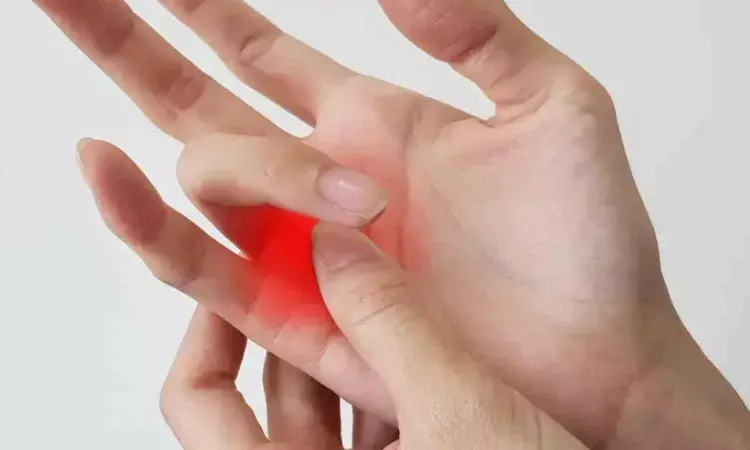- Home
- Medical news & Guidelines
- Anesthesiology
- Cardiology and CTVS
- Critical Care
- Dentistry
- Dermatology
- Diabetes and Endocrinology
- ENT
- Gastroenterology
- Medicine
- Nephrology
- Neurology
- Obstretics-Gynaecology
- Oncology
- Ophthalmology
- Orthopaedics
- Pediatrics-Neonatology
- Psychiatry
- Pulmonology
- Radiology
- Surgery
- Urology
- Laboratory Medicine
- Diet
- Nursing
- Paramedical
- Physiotherapy
- Health news
- Fact Check
- Bone Health Fact Check
- Brain Health Fact Check
- Cancer Related Fact Check
- Child Care Fact Check
- Dental and oral health fact check
- Diabetes and metabolic health fact check
- Diet and Nutrition Fact Check
- Eye and ENT Care Fact Check
- Fitness fact check
- Gut health fact check
- Heart health fact check
- Kidney health fact check
- Medical education fact check
- Men's health fact check
- Respiratory fact check
- Skin and hair care fact check
- Vaccine and Immunization fact check
- Women's health fact check
- AYUSH
- State News
- Andaman and Nicobar Islands
- Andhra Pradesh
- Arunachal Pradesh
- Assam
- Bihar
- Chandigarh
- Chattisgarh
- Dadra and Nagar Haveli
- Daman and Diu
- Delhi
- Goa
- Gujarat
- Haryana
- Himachal Pradesh
- Jammu & Kashmir
- Jharkhand
- Karnataka
- Kerala
- Ladakh
- Lakshadweep
- Madhya Pradesh
- Maharashtra
- Manipur
- Meghalaya
- Mizoram
- Nagaland
- Odisha
- Puducherry
- Punjab
- Rajasthan
- Sikkim
- Tamil Nadu
- Telangana
- Tripura
- Uttar Pradesh
- Uttrakhand
- West Bengal
- Medical Education
- Industry
Percutaneous A1 Pulley Release Outperforms Steroid Injection in Improving Functional Mobility for Trigger Finger: Study

Trigger finger (TF) causes pain and impaired hand function. Percutaneous release of the A1 pulley demonstrates a better outcome than steroid injection in the treatment of TF; however, evidence remains limited. Mandeep Karki et al conducted a study to compare the effect of percutaneous release of the A1 pulley compared to local steroid injection in the treatment of trigger fingers.
A hospital-based randomized clinical trial among 92 patients aged 18 years and above suffering from trigger fingers that were unresponsive to conservative treatment was conducted to evaluate the effect of the percutaneous release of A1 pulley and steroid injection. Quinnell’s classification, visual analogue scale (VAS) scoring system and thickness of A1 pulley, as well as the flexor tendon in the affected site, were assessed before and after intervention at six months. Student’s t-test, Mann-Whitney U test and chi-square tests were performed to compare the effectiveness of both treatments.
The key findings of the study were:
• Percutaneous release of the A1 pulley showed better functional improvement than steroid injection, with a p-value of < 0.001 and medium effect size of 0.43.
• The pain score was also decreased more in the percutaneous release group than the steroid group (-5.1 ± 1.4 versus − 3.7 ± 1.8), with the group difference of 1.3 (95% CI: 0.6 to 2.0), with a p-value of < 0.001 and a large effect size of 0.87.
• Nevertheless, steroid injection decreased the thickness of A1 pulley than percutaneous release (-0.34 ± 0.24 versus − 0.21 ± 0.21), with a p-value of 0.011 and a large effect size of 0.5.
• Tendon thickness was decreased more in the steroid group compared with the percutaneous release group (-1.12 ± 0.73 versus − 0.34 ± 0.41), with a p-value of < 0.001 and a huge effect size of 1.31.
The authors opined – ‘Percutaneous release of A1 pulley illustrated greater improvement in functional mobility with a moderate effect and pain reduction with a large effect compared to steroid injection. Likewise, all participants in the percuta¬neous release group showed symptomatic improvements, whereas approximately 15% of those in the steroid group needed re-intervention. The steroid injection group exhibited a greater reduction in the thickness of the A1 pulley and tendon sheath than the percutaneous A1 pul¬ley release group, suggesting that the pulley thickness may not be directly related to clinical outcome. Further multi-center trials with larger sample sizes and diverse participant populations are recommended to strengthen the evidence in this area.’
Further reading:
Effect of percutaneous release versus steroid injection among adults with trigger fingers: a randomized clinical trial Mandeep Karki et al BMC Musculoskeletal Disorders (2025) 26:885 https://doi.org/10.1186/s12891-025-08981-6
MBBS, Dip. Ortho, DNB ortho, MNAMS
Dr Supreeth D R (MBBS, Dip. Ortho, DNB ortho, MNAMS) is a practicing orthopedician with interest in medical research and publishing articles. He completed MBBS from mysore medical college, dip ortho from Trivandrum medical college and sec. DNB from Manipal Hospital, Bengaluru. He has expirence of 7years in the field of orthopedics. He has presented scientific papers & posters in various state, national and international conferences. His interest in writing articles lead the way to join medical dialogues. He can be contacted at editorial@medicaldialogues.in.


